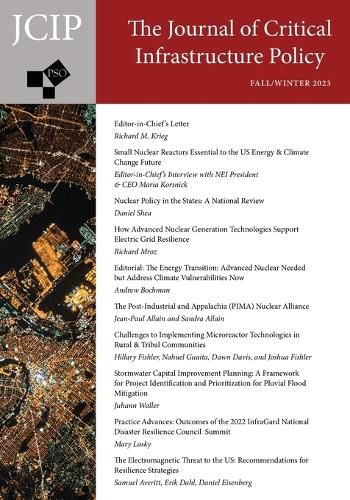Readings Newsletter
Become a Readings Member to make your shopping experience even easier.
Sign in or sign up for free!
You’re not far away from qualifying for FREE standard shipping within Australia
You’ve qualified for FREE standard shipping within Australia
The cart is loading…






It is increasingly evident that the development of microreactors, small modular reactors (SMRs), and other advanced reactor designs will be needed to produce the least cost plan to decarbonize the nation's energy sources by 2050. Much of this JCIP issue supports the view that the deployment of these small reactors should be moved to the forefront of national policy. A reduction in nuclear plant size is essential to decrease capital costs and to increase plant safety. Small reactors in the US fleet would be factory-assembled with advanced quality control. They would incorporate passive safety systems as well as safer 10-year refueling cycles, faster component production, and greater economies of scale. Moreover, microreactors could power individual industrial plants, military bases, remote communities, and be rapidly deployed to natural disaster areas. These smaller units could also contribute to renewable heating. And with many nations jockeying for primacy in what is anticipated to be a market exceeding a trillion dollars, it is essential that the US maintain technological leadership and manufacturing capacity in the advanced nuclear sector.
More rapid deployment of this promising technology will require adequate federal R&D support, an increased domestic nuclear fuel supply (both LEU and HALEU), with solid progress in streamlining regulatory barriers. In particular, the total time required for development and regulatory reviews must be reduced in a smart fashion.
Previous issues of the Journal have addressed how SMRs could enhance electric grid and critical infrastructure resilience. They included the development of resilient nuclear power plants, resilient critical infrastructure islands and the ability of SMRs to function as grid black start units.4 We recently published a cornerstone article by Decker and Rauhut on incentivizing good governance beyond regulatory minimums in the civil nuclear sector.
Table of Contents Editor-in-Chief 's Letter Richard M. Krieg
Small Nuclear Reactors Essential to the US Energy & Climate Change Future Editor-in-Chief's Interview with NEI President & CEO Maria Korsnick
Nuclear Policy in the States: A National Review Daniel Shea
How Advanced Nuclear Generation Technologies Support Electric Grid Resilience Richard Mroz
Editorial: The Energy Transition: Advanced Nuclear Needed but Address Climate Vulnerabilities Now Andrew Bochman
The Post-Industrial and Appalachia (PIMA) Nuclear Alliance Jean-Paul Allain and Sandra Allain
Challenges to Implementing Microreactor Technologies in Rural & Tribal Communities Hillary Fishler, Nahuel Guaita, Dawn Davis, and Joshua Fishler
Stormwater Capital Improvement Planning: A Framework for Project Identification and Prioritization for Pluvial Flood Mitigation Juhann Waller
Practice Advances: Outcomes of the 2022 InfraGard National Disaster Resilience Council Summit Mary Lasky
The Electromagnetic Threat to the US: Recommendations for Resilience Strategies Samuel Averitt, Erik Dahl, Daniel Eisenburg
$9.00 standard shipping within Australia
FREE standard shipping within Australia for orders over $100.00
Express & International shipping calculated at checkout
It is increasingly evident that the development of microreactors, small modular reactors (SMRs), and other advanced reactor designs will be needed to produce the least cost plan to decarbonize the nation's energy sources by 2050. Much of this JCIP issue supports the view that the deployment of these small reactors should be moved to the forefront of national policy. A reduction in nuclear plant size is essential to decrease capital costs and to increase plant safety. Small reactors in the US fleet would be factory-assembled with advanced quality control. They would incorporate passive safety systems as well as safer 10-year refueling cycles, faster component production, and greater economies of scale. Moreover, microreactors could power individual industrial plants, military bases, remote communities, and be rapidly deployed to natural disaster areas. These smaller units could also contribute to renewable heating. And with many nations jockeying for primacy in what is anticipated to be a market exceeding a trillion dollars, it is essential that the US maintain technological leadership and manufacturing capacity in the advanced nuclear sector.
More rapid deployment of this promising technology will require adequate federal R&D support, an increased domestic nuclear fuel supply (both LEU and HALEU), with solid progress in streamlining regulatory barriers. In particular, the total time required for development and regulatory reviews must be reduced in a smart fashion.
Previous issues of the Journal have addressed how SMRs could enhance electric grid and critical infrastructure resilience. They included the development of resilient nuclear power plants, resilient critical infrastructure islands and the ability of SMRs to function as grid black start units.4 We recently published a cornerstone article by Decker and Rauhut on incentivizing good governance beyond regulatory minimums in the civil nuclear sector.
Table of Contents Editor-in-Chief 's Letter Richard M. Krieg
Small Nuclear Reactors Essential to the US Energy & Climate Change Future Editor-in-Chief's Interview with NEI President & CEO Maria Korsnick
Nuclear Policy in the States: A National Review Daniel Shea
How Advanced Nuclear Generation Technologies Support Electric Grid Resilience Richard Mroz
Editorial: The Energy Transition: Advanced Nuclear Needed but Address Climate Vulnerabilities Now Andrew Bochman
The Post-Industrial and Appalachia (PIMA) Nuclear Alliance Jean-Paul Allain and Sandra Allain
Challenges to Implementing Microreactor Technologies in Rural & Tribal Communities Hillary Fishler, Nahuel Guaita, Dawn Davis, and Joshua Fishler
Stormwater Capital Improvement Planning: A Framework for Project Identification and Prioritization for Pluvial Flood Mitigation Juhann Waller
Practice Advances: Outcomes of the 2022 InfraGard National Disaster Resilience Council Summit Mary Lasky
The Electromagnetic Threat to the US: Recommendations for Resilience Strategies Samuel Averitt, Erik Dahl, Daniel Eisenburg